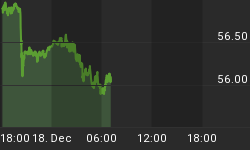Gold did move higher in response to silver's late January breakout, but it did not succeed in breaking free of the influence of its long-term uptrend return line and advancing significantly as expected, and is therefore now vulnerable at best to a period of consolidation and at worst to a significant reaction. The first cracks appeared on Tuesday with a $20 plunge, that was not made good by the strong performance on Thursday, which is viewed as providing traders with another chance to cut positions. This drop was partly precipitated by dollar strength, forecast in the Bin Laden article some weeks back. Note that we are not calling a top in gold here - longer-term it is set to go MUCH higher - but a period of consolidation/reaction looks likely first.

Short-term charts do not reveal the reasons for gold's recent behaviour, so we will start by looking at the 5-year chart. On this chart the reason for gold's creeping advance during much of January and into February becomes immediately clear - it was battling resistance in the vicinity of the upper return line of its long-term uptrend channel, and being unable to break free of it, it suddenly plunged on Tuesday. On this chart two other important observations can also be made. The recent advance has been very steep, historically, and it has resulted in a large gap with the 200-day moving average, and a gap between the 50 and 200-day moving averages that is normally unsustainable and leads to a reaction. The word "normally" is used because there is a lot of talk going around about the looming attack on Iran, and this may indeed be a factor driving gold's strong advance. Now obviously, if Iran is attacked, gold can be expected to go ballistic (no pun intended) and top lines of channels will not impede it, but when it is it will probably be a surprise attack, and it may be some months away, or longer, leaving room for gold to correct in the meantime.

On the 6-month we can view recent action in much more detail, especially how gold struggled to make progress during much of January and into February and the now very large gap between the moving averages. The short-term overbought condition has now unwound to a considerable degree however, as shown by the RSI and MACD indicators at the top and bottom of the chart, although this won't stop it falling if it's in corrective mode, however, it does mean that there is room for a break to the upside, which would be signalled by 2 closes above $580, although for the reasons already discussed, this is considered unlikely.

The XAU index long-term chart provides additional evidence that the sector is due for a rest at best, and a significant retreat at worst. This index has risen strongly for some months and has pushed up into, but not surmounted, a wide zone of strong resistance that goes back many years. While we do not generally ascribe too much importance to resistance that goes back a very long time, in this case it is considered to be foolhardy to underestimate the potential of this resistance zone to stall out this advance, on account of the fact that the index has risen steeply into it and is thus very overbought and vulnerable. The big gold stocks in particular, which are of course important constituents of this index, remain very overbought and could fall victim to major profit taking leading to a self-feeding cycle of liquidation, that brings them back into buying territory. The XAU chart also implies that a significant reaction in gold is on the cards.
Conclusion: gold is believed to be entering a period of correction, during which it will either consolidate or react, which may last some weeks. It is considered unlikely that any reaction would take it below $500. Any such reaction would provide a golden opportunity to buy/increase positions in a large raft of gold stocks. This scenario will be made much less likely if gold succeeds in making 2 closes above $580.















